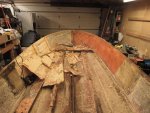Greetings all,
This spring, I decided it was time to rip my boat apart and determine any damages or wear caused by it's long life span. I have a 1981 Ebbtide (Dynatrak I believe?) Bass boat. It's a sixteen footer so not too much on my plate so far. I ripped up all the carpet, and all the "additions" made by previous owners, restoring it to it's somewhat original state. I really like the layout now, and I'm gonna try restoring some of its beauty.
I ran into an issue outside my scope of knowledge though. Upon tearing up the center floor (lower platform) I discovered that a previously mounted seat pedestal had seen better days. Upon removing it, I was met with some soft and brittle fiberglass that gave out when stepping on it. I decided to cutout all the dead glass, leaving a hole in the floor. I'm tasked with restoring the hole and reinstalling a pedestal. This is where I could use some help.
So it seems there's a lot of ways I can go about this. Initially I was going to patch the hole with glass and then screw in the pedestal. That doesn't sound like a good idea now that I've been reading, because pedestals leverage a lot of weight and the fiber glass won't hold. So if I need somekind of backing to reinforce support, how am I suppose to install that backing if I can't get to the underside of the boat?
Without dragging on about every possible method, here are some pictures. My question is, if you yourself were to install a flush or surface mounted pedestal base at this location, how would you go about it. If there's any details that I haven't provided, let me know. Thanks a lot!
This spring, I decided it was time to rip my boat apart and determine any damages or wear caused by it's long life span. I have a 1981 Ebbtide (Dynatrak I believe?) Bass boat. It's a sixteen footer so not too much on my plate so far. I ripped up all the carpet, and all the "additions" made by previous owners, restoring it to it's somewhat original state. I really like the layout now, and I'm gonna try restoring some of its beauty.
I ran into an issue outside my scope of knowledge though. Upon tearing up the center floor (lower platform) I discovered that a previously mounted seat pedestal had seen better days. Upon removing it, I was met with some soft and brittle fiberglass that gave out when stepping on it. I decided to cutout all the dead glass, leaving a hole in the floor. I'm tasked with restoring the hole and reinstalling a pedestal. This is where I could use some help.
So it seems there's a lot of ways I can go about this. Initially I was going to patch the hole with glass and then screw in the pedestal. That doesn't sound like a good idea now that I've been reading, because pedestals leverage a lot of weight and the fiber glass won't hold. So if I need somekind of backing to reinforce support, how am I suppose to install that backing if I can't get to the underside of the boat?
Without dragging on about every possible method, here are some pictures. My question is, if you yourself were to install a flush or surface mounted pedestal base at this location, how would you go about it. If there's any details that I haven't provided, let me know. Thanks a lot!































